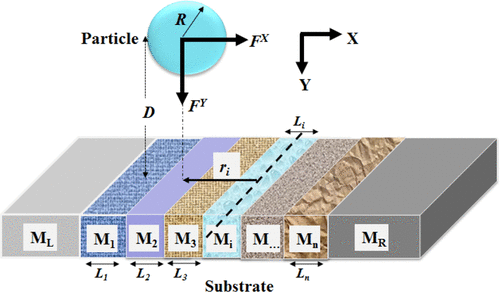Our official English website, www.x-mol.net, welcomes your
feedback! (Note: you will need to create a separate account there.)
London-van der Waals Force Field of a Chemically Patterned Surface To Enable Selective Adhesion
Langmuir ( IF 3.7 ) Pub Date : 2018-12-12 00:00:00 , DOI: 10.1021/acs.langmuir.8b03502 Ravi P. Jaiswal 1 , Stephen P. Beaudoin 2
Langmuir ( IF 3.7 ) Pub Date : 2018-12-12 00:00:00 , DOI: 10.1021/acs.langmuir.8b03502 Ravi P. Jaiswal 1 , Stephen P. Beaudoin 2
Affiliation

|
The London-van der Waals (L-vdW) force between a particle and a surface strongly depends on the topography and the chemical properties of the interacting surfaces. Although a great deal of work has been done to understand the effect of topographical heterogeneity on the L-vdW adhesion, the role of chemical heterogeneity has been discussed only rarely. This study makes an attempt to quantify the magnitude and range of the L-vdW force acting on a spherical particle in the vicinity of a chemically patterned surface. Specifically, an ideal system of a smooth spherical particle approaching a surface composed of parallel stripes of chemically distinct materials with different Hamaker constants is considered. The L-vdW forces for such systems are determined by solving the London dispersion potential for the entire volumes of the adhering bodies from first principles, using Hamaker’s microscopic approach. The computational results elucidate that a chemical interface can apply a tangential L-vdW force, in addition to the normal L-vdW force, on nearby particles. This can cause lateral motion of particles neighboring a chemically inhomogeneous surface. The magnitude of the tangential L-vdW force is found to be maximum when the particle is centered at the interface and shows a gradual drop as it moves away from this location. The magnitude and range of the tangential L-vdW force can be large for large colloidal particles in close contact with a chemically patterned surface whose materials have distinct Hamaker constants. This study suggests that the tangential L-vdW force field generated by a chemical interface can be utilized as a tool to manipulate the path of an approaching particle to facilitate selective adhesion.
中文翻译:

化学图案表面的伦敦范德华力场以实现选择性粘附
粒子与表面之间的伦敦范德华力(L-vdW)很大程度上取决于相互作用表面的形貌和化学性质。尽管已经做了大量工作来了解地形异质性对L-vdW粘附的影响,但化学异质性的作用很少被讨论。这项研究试图量化作用在化学图案化表面附近的球形颗粒上的L-vdW力的大小和范围。具体而言,考虑了一种理想的光滑球形颗粒系统,该系统接近具有不同Hamaker常数的化学性质不同的材料的平行条纹组成的表面。此类系统的L-vdW力是通过使用Hamaker的微观方法从第一原理求解整个粘附体体积的伦敦弥散势来确定的。计算结果表明,除了正常的L-vdW力外,化学界面还可以在附近的粒子上施加切向的L-vdW力。这可能会导致邻近化学不均匀表面的粒子发生横向运动。当粒子位于界面中心时,切向L-vdW力的大小最大,并且随着远离该位置而逐渐下降。切向L-vdW力的大小和范围对于与化学构图表面紧密接触的大胶体粒子来说可能很大,该化学构图表面的材料具有独特的Hamaker常数。
更新日期:2018-12-12
中文翻译:

化学图案表面的伦敦范德华力场以实现选择性粘附
粒子与表面之间的伦敦范德华力(L-vdW)很大程度上取决于相互作用表面的形貌和化学性质。尽管已经做了大量工作来了解地形异质性对L-vdW粘附的影响,但化学异质性的作用很少被讨论。这项研究试图量化作用在化学图案化表面附近的球形颗粒上的L-vdW力的大小和范围。具体而言,考虑了一种理想的光滑球形颗粒系统,该系统接近具有不同Hamaker常数的化学性质不同的材料的平行条纹组成的表面。此类系统的L-vdW力是通过使用Hamaker的微观方法从第一原理求解整个粘附体体积的伦敦弥散势来确定的。计算结果表明,除了正常的L-vdW力外,化学界面还可以在附近的粒子上施加切向的L-vdW力。这可能会导致邻近化学不均匀表面的粒子发生横向运动。当粒子位于界面中心时,切向L-vdW力的大小最大,并且随着远离该位置而逐渐下降。切向L-vdW力的大小和范围对于与化学构图表面紧密接触的大胶体粒子来说可能很大,该化学构图表面的材料具有独特的Hamaker常数。































 京公网安备 11010802027423号
京公网安备 11010802027423号